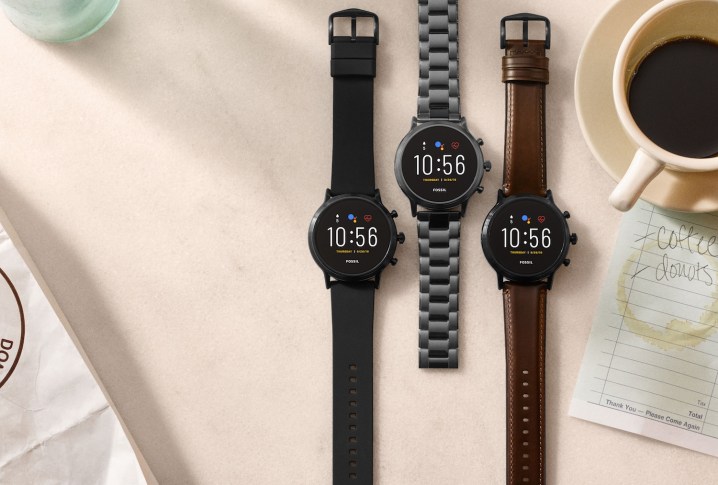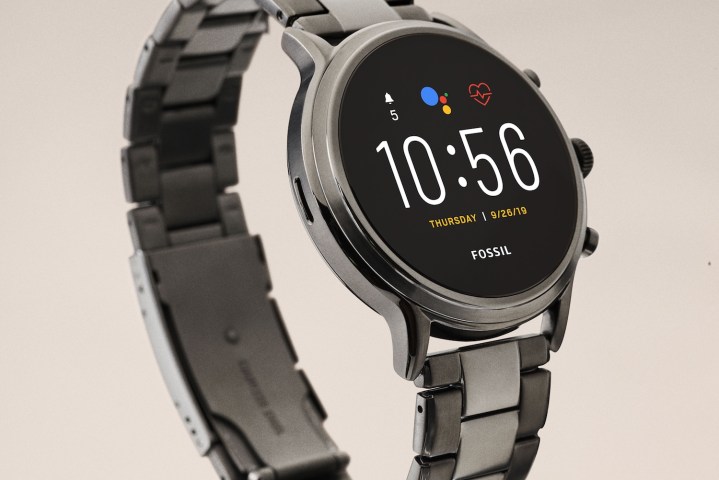
With its new smartwatch, Fossil is giving us what we want: Longer battery life, more memory for improved performance, and better integration with the iPhone. The company has introduced its fifth-generation Carlyle and Julianna smartwatch, with all of these features and more, which is available from Monday, August 5. Digital Trends spoke about it with Greg McKelvey, Fossil Group’s chief commercial officer and Jeff Boyer, Fossil Group’s chief financial officer.
Battery life improvements
“We’ve now been in wearables for four years, and every year we have a substantial upgrade. In our next-gen watch, we focused on a number of things that people asked for,” Jeff Boyer told us, explaining the reasons behind the watch’s creation and the new features. The first and most interesting new addition is the Extended Battery Mode. It offers four preset battery modes to help stretch out the smartwatch’s use time.
“We’ve enabled you to get two to three days battery life or more with a single swipe,” Boyer said. The new watch runs Google’s Wear OS, but Fossil has made it far simpler to find the new battery modes, as instead of a separate app, the battery mode is found by swiping down on the screen and tapping a battery icon. There are four options: Daily, Extended, Time-Only, and Custom.

Daily mode is how we use our smartwatches now, with everything enabled and features such as the always-on screen active. Switch to Extended, and the always-on screen is switched off, plus the Bluetooth connection is tweaked — you still get notifications and health data will sync, but perhaps not instantly. Cleverly, Fossil will monitor the trade-off between functionality and battery life once the watch is on sale, then tweak the algorithm to improve performance over time. Custom mode puts you in control of what features remain active.
iPhone enhancements
Wear OS smartwatches today often don’t have a battery that lasts more than a day, unless, like the Casio Pro Trek WSD-F30 or Mobvoi TicWatch Pro, they use a second screen, so Fossil’s improvements will be welcome. The other major new feature will come with a software update in the near future — the ability to answer calls on a watch that’s linked to an iPhone. Previously, this has only been available to Android phone users.
McKelvey told us, “it’s a seamless experience, integrated and complementary to the operating system,” while emphasizing the close partnership between Google and Fossil Group’s own engineering team that made the feature possible. Taking calls on an iPhone-connected watch will work in exactly the same way as it does on Android, without a separate app or interface on the watch. Additionally, iPhone owners will also be able to hear Google Assistant, use Google Translate, and play third-party music on the watch too.
Calls will be taken and heard through a new swim-proof speaker and microphone, which removes the need for a mesh barrier to keep out water, ensuring clear sound. McKelvey was also keen to point out that work has been done on the Android calling feature too, saying improvements have been made in the transition between the phone and the smartwatch when taking a call, including when switching mid-call between watch, phone, and even a car infotainment system.
Technology and style

Fossil’s fifth-generation watch is built on Qualcomm’s Snapdragon 3100 processor, which has only been seen a handful of smartwatches so far. The good news here is it’s paired with 1GB of RAM and 8GB of storage space.
“We expect substantial performance improvements overall,” Boyer said confidently.
The increased storage provides more space for your own media, plus a selection of preinstalled apps. While preinstalled apps on phones are rarely welcome, it’s good to see some on a smartwatch, as they’re sometimes overlooked by newcomers. The apps include Spotify, Cardiogram, and personal safety app Noonlight.
How about the rest of the watch? Both the Carlyle and Julianna models have 44mm cases made from stainless steel, and the screen measures 1.3 inches. There’s a heart rate sensor on the back, and sensors inside the watch include NFC, GPS, and an accelerometer. There are six different models, and the differences between the Carlyle and Julianna comes down to color scheme and strap.
Fossil expects four different brands — the Fossil Group makes smartwatches for companies including Kate Spade, Diesel, and Armani — to launch smartwatches using the new technology this year, and eventually to have more than 100 different versions — this includes color and style variations — available. If Fossil’s fifth-generation watch and its new features are what you’ve been waiting for, it appears you’re going to be spoiled for choice.
The first Fossil-branded version is available at fossil.com for $295.
Editors' Recommendations
- Nomad’s new iPhone case and Apple Watch band may be its coolest yet
- iPhone SE 4: news, rumored price, release date, and more
- This new folding phone costs less than half the price of the iPhone 15 Pro Max
- iOS 18 could make my iPhone look like Android, and I hate it
- Your iPhone just got a new iOS update, and you should download it right now




